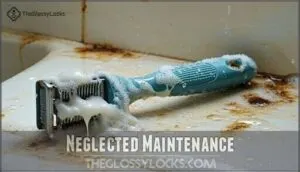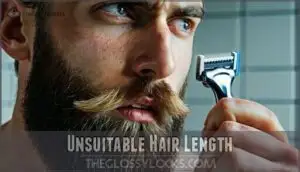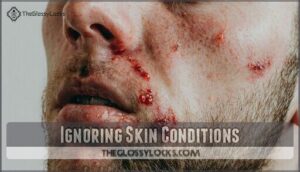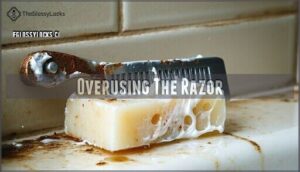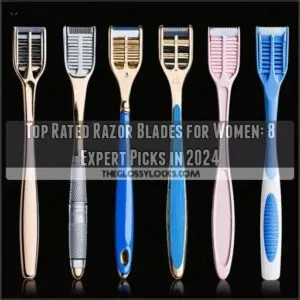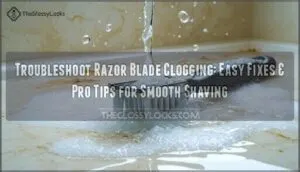This site is supported by our readers. We may earn a commission, at no cost to you, if you purchase through links.
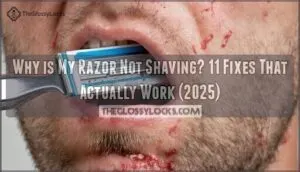
When you wonder why your razor isn’t shaving effectively, check if you’re pressing too hard, shaving against the grain, or using worn-out blades.
Clogged cutting surfaces from hair buildup also reduce performance substantially.
Dry skin without proper lubrication creates drag, making smooth cuts impossible, and hair that’s too long or too short presents additional challenges.
Neglected maintenance leaves your razor struggling to perform, and even the wrong razor type for your hair texture can turn your morning routine into a frustrating battle that leaves you with patchy results and irritated skin.
Table Of Contents
- Key Takeaways
- Why is My Razor Not Shaving?
- Wrong Shaver Type
- Dull Blade
- Improper Shaving Technique
- Clogging Issues
- Insufficient Preparation
- Neglected Maintenance
- Unsuitable Hair Length
- Skin Sensitivity
- Ignoring Skin Conditions
- Overusing The Razor
- Frequently Asked Questions (FAQs)
- Why is my razor not shaving?
- Why is my Shaver not working?
- Why is my electric razor not cutting hair?
- Why does my electric razor pull on my skin when I Shave?
- Why is my razor struggling?
- Why are my Shaver blades so bad?
- Why is my razor not shaving properly?
- Why is there still stubble after I shave?
- Why is my new razor not cutting my hair?
- Why is my razor not working?
- Conclusion
Key Takeaways
- Replace dull blades regularly – You’ll know it’s time when your razor tugs at hair instead of cutting cleanly, typically after 5-7 shaves for cartridge razors or 3-7 uses for safety razor blades.
- Clean your razor thoroughly after each use – Rinse with hot water during and after shaving to prevent hair, soap, and dead skin buildup that blocks the cutting edge and reduces performance.
- Prepare your skin properly before shaving – Cleanse your face, soften hair with warm water, and apply pre-shave oil or cream to create a protective barrier and reduce friction.
- Use the right technique and pressure – Shave with or across the grain (never against it), apply gentle pressure, and let the razor do the work instead of pressing hard against your skin.
Why is My Razor Not Shaving?
Razor troubles can turn your morning routine into a frustrating ordeal. When your razor not shaving properly, several culprits might be at play.
Dull razor blade issues top the list, followed by clogged razor problems from hair and soap buildup. Poor shaving technique and inadequate razor maintenance also contribute to lackluster results.
Razor assembly errors, insufficient lather quality, wrong shaving pressure, and neglected blade lubrication compound the problem. Your razor lifespan depends on proper care and technique.
Hair length, skin preparation, and choosing the right shaver type all impact performance. Using a razor with ergonomic handle designs can greatly improve control.
Understanding these factors helps you achieve consistently smooth, comfortable shaves every time.
Wrong Shaver Type
Many people struggle with poor shaving results simply because they’re using the wrong razor type for their specific needs. Your shaver head choice makes all the difference between a smooth shave and a frustrating experience.
Finding the perfect razor match transforms your daily shave from a chore into effortless grooming success.
Rotary vs foil comes down to your hair and skin characteristics. Foil shavers work best on straight, fine hair and provide closer cuts on flat surfaces. They’re gentler on sensitive skin but struggle with coarse, thick beards.
Rotary shavers excel at tackling curly, wiry hair and adapt better to facial contours, though they require circular motions that can irritate if done incorrectly.
Beard density matters when selecting shaver types. Thick, coarse hair needs the power of rotary systems, while fine hair responds better to foil technology. Skin type impact is equally important – sensitive skin benefits from foil designs, while normal skin can handle rotary systems.
One key difference is that foil shavers use blades housed beneath the foil to cut hairs.
Consider your shaver power needs too. Cordless models offer convenience, while corded electric shavers provide consistent performance for demanding beards.
Dull Blade
Finding the right shaver type won’t help if your blade has lost its edge. A dull blade is often the main reason your razor is not shaving effectively. When blade sharpness deteriorates, you’ll notice the razor dragging instead of gliding smoothly across your skin.
Dull blades create multiple problems that affect your shaving experience. They can’t slice through hair cleanly, causing an uncomfortable tugging sensation. Poor blade quality or extended use without replacement leads to increased friction and skin irritation.
Signs your blade needs replacing:
- Tugging sensation: The razor pulls at hairs instead of cutting them cleanly
- Patchy results: You’re missing spots and need multiple passes over the same area
- Increased irritation: More razor burn, redness, and potential nicks
Blade material and proper blade storage affect how long your razor stays sharp. To avoid this, consider best practices for extending blade life. Most cartridge blades should be replaced every 5-7 shaves, depending on your shaving frequency and hair coarseness. Even the best blade angle won’t compensate for a worn-out edge.
Improper Shaving Technique
Your shaving technique makes or breaks your razor’s performance. Poor razor handling creates irritation instead of smoothness.
Avoid pressing hard – gentle angle and pressure work better. Grain direction matters most, especially on sensitive neck areas. Always shave with or across the grain, never against it.
Circular motion suits electric razors perfectly. Multi-pass shaving gets better results: first pass with the grain, second for closeness.
To prevent irritation, apply aftershave balm to soothe the skin. Technique adaptation takes practice, but proper shaving practices transform your experience from frustrating to fantastic.
Clogging Issues
When your razor feels like it’s barely touching the surface, debris buildup is often the hidden troublemaker.
Hair clippings, dead skin cells, and shaving cream residue create a barrier between your blade and skin, making your razor not shaving effectively.
Water rinsing is your first line of defense.
Hot water works best – it dissolves soap residue and flushes out trapped hairs.
Don’t just splash and go; give your razor a thorough swish after every few strokes.
Cold water actually makes things worse by hardening any remaining shaving cream.
Your cleaning frequency matters more than you think.
A clogged razor needs attention during and after each shave.
Residue removal isn’t just about rinsing – sometimes you’ll need to gently tap the razor head or use a soft brush to dislodge stubborn buildup.
Choose your shaving cream wisely.
Heavy, thick formulas might feel luxurious, but they’re more likely to gum up your blade.
Lighter creams rinse away cleanly, keeping your razor performing at its peak.
Razor hygiene prevents most performance issues before they start.
Using pre-shave oil can enhance razor glide.
Insufficient Preparation
Your razor not shaving properly often stems from poor skin preparation. Rushing through your pre-shave routine creates unnecessary friction and irritation. Proper shaving preparation makes all the difference between a smooth shave and a frustrating experience.
Essential steps for effective skin preparation:
- Cleanse thoroughly – Remove oils and dirt that interfere with lather application
- Hydrate your skin – Warm water softens facial hair for easier cutting
- Apply pre-shave products – Oils or creams create protective barriers
These shaving techniques guarantee beard softening and better razor performance. Using pre-shave oils can further reduce friction.
Neglected Maintenance
Skipping razor maintenance leads to poor shaving performance and frustration. Clean your razor after every use to prevent hair, dirt, and product buildup from clogging the cutting mechanism.
Clean blades cut smoothly, dirty blades drag painfully—your morning routine depends on this simple truth.
Lubrication importance can’t be overstated – apply clipper oil regularly to keep moving parts smooth and prevent skin dragging. Like clipper oil, using protective coatings helps prevent corrosion and extend blade life.
| Maintenance Task | Cleaning Frequency | Buildup Effects |
|---|---|---|
| Basic rinse | After each shave | Prevents hair accumulation |
| Deep cleaning | Weekly | Removes soap residue |
| Component disassembly | Monthly | Thorough debris removal |
| Blade replacement | Every 5-7 shaves | Maintains sharpness |
| Automated stations | As needed | Complete sanitization |
Replace dull blades regularly and consider automated stations for thorough razor care.
Unsuitable Hair Length
Beyond maintenance issues, your hair length might be sabotaging your shaving efforts. Think of it like mowing tall grass with a push mower—it just won’t work effectively.
Most razors handle hair up to 5mm, but anything longer creates problems. Long hair problems include clogging, tugging, and incomplete cuts that leave you frustrated. Your razor wasn’t designed to tackle a full beard in one go.
Pre-shave trimming solves this instantly. Use scissors or a beard trimmer to cut hair down to manageable lengths before shaving. Trimming frequency depends on your growth rate—fast growers need weekly trims, while others can go longer.
Razor cuts, which are different from shaving, can add texture and volume to longer hairstyles.
Beard length matters more than you think. Electric shavers work best on 2-3mm hair, while safety razors prefer even shorter lengths. Many modern shavers include trimming attachments specifically for this purpose.
Match your shaving technique to your hair’s current state. Proper preparation prevents razor drag, reduces irritation, and delivers the smooth results you’re after. These simple shaving tips transform your routine completely.
Skin Sensitivity
Your skin might be telling you to slow down. If you have sensitive skin, certain razors and techniques can turn your daily routine into a painful ordeal. Poor shave quality often stems from skin sensitivity rather than equipment failure.
When razor burn and ingrown hairs become regular visitors, it’s time to adjust your approach. Skin adaptation takes patience, but these changes make all the difference:
- Choose gentle foils designed for sensitive skin types to minimize shaving irritation
- Embrace exfoliation benefits by removing dead skin cells before each shave
- Apply pre-shave oil to create a protective barrier between blade and skin
- Follow up with soothing aftershave use to calm redness and inflammation
Your skin needs care, not conquest. Using fragrance-free products can help minimize irritation. Treat it gently, and you’ll see remarkable improvements.
Ignoring Skin Conditions
Many people overlook how existing skin conditions can turn a simple shave into a frustrating ordeal. Conditions like eczema, psoriasis, and acne create barriers that prevent smooth shaving and increase irritation risks.
- **Ignoring these underlying issues guarantees poor shaving results and prolonged discomfort.
Eczema shaving requires extra moisture since flaky, inflamed skin catches razor blades. Psoriasis shaving demands gentle techniques to avoid triggering flare-ups on raised, scaly patches. Acne shaving needs careful navigation around breakouts to prevent spreading bacteria.
Dry skin creates a rough surface where hairs get trapped, leading to ingrown hairs. Regular moisturizing softens skin while exfoliation prevents hair from curling back into follicles. Razor burn and post-shave irritation decrease substantially when you use soothing aftershaves with gentle ingredients. For some, this may even manifest as seborrheic dermatitis symptoms.
Addressing these neglected skin conditions transforms your shaving experience from painful to pleasant.
Overusing The Razor
Your razor isn’t cutting properly because you’re pushing it past its limits. Razor overuse leads to blade wear that compromises shaving performance. Most people ignore the signs until their morning routine becomes a wrestling match with stubble.
Dull blades from excessive use create skin fatigue and over-exfoliation. You’re basically dragging metal across your face instead of cutting hair cleanly. This causes irritation, razor burn, and patchy results that leave you frustrated.
Track your shaving frequency and razor blade sharpness. Cartridge razors typically last 5-10 shaves, while safety razor blades need replacement after 3-7 uses. Electric shaver heads require changing every 12-18 months depending on usage. To extend the life of your blades, consider proper razor cleaning.
Don’t stretch razor lifespan beyond recommended limits. Replace blades when you notice tugging, increased pressure requirements, or uneven cutting. Fresh blades make shaving effortless and comfortable again.
Frequently Asked Questions (FAQs)
Why is my razor not shaving?
Your razor might’ve a dull blade, incorrect assembly, or buildup blocking the cutting edge. Check if you’ve installed the blade properly, clean thoroughly, and replace worn blades for effective shaving.
Why is my Shaver not working?
Like a broken compass pointing nowhere, your shaver’s lost its direction.
You’ve likely got dull blades, clogged cutting heads, or incorrect assembly.
Check blade sharpness, clean thoroughly, and make certain of proper angle for smooth sailing.
This will ensure your shaver is working correctly and provide a better shaving experience.
Why is my electric razor not cutting hair?
Your electric razor might’ve dull blades, clogged cutting heads, or incorrect assembly.
Try cleaning thoroughly, replacing worn blades, checking proper installation, and ensuring you’re using the right shaving angle and technique.
Why does my electric razor pull on my skin when I Shave?
John winced as his electric razor tugged at his morning stubble like a broken lawnmower.
Your shaver’s pulling because you’re pressing too hard, the blades are dull, or you need better pre-shave prep to soften whiskers first.
Why is my razor struggling?
Several factors can cause your razor to struggle.
You might’ve a dull blade, incorrect shaving angle, clogged cutting heads, or hair that’s too long.
Try replacing the blade and cleaning thoroughly first.
Why are my Shaver blades so bad?
About 70% of shaving complaints stem from dull blades.
Your shaver blades might be worn out, clogged with hair and soap, or you’re using poor-quality replacements that don’t match your skin type.
Why is my razor not shaving properly?
Your razor likely has a dull blade, incorrect assembly, or needs cleaning. Check if you’ve installed the blade properly, replace worn blades, and remove hair buildup blocking effective cutting.
Why is there still stubble after I shave?
You’re barking up the wrong tree if you think one pass does it all.
Your blade’s probably dull, you’re using poor technique, or you need multiple passes with proper grain mapping for that baby-smooth finish.
Why is my new razor not cutting my hair?
Check if you’ve forgotten to insert a blade – it’s surprisingly common. Your blade might be dull, installed incorrectly, or the razor assembled wrong. Try replacing the blade first.
Why is my razor not working?
Is your blade hitting a brick wall instead of cutting through hair? You’re likely dealing with a dull blade, incorrect assembly, or clogged razor head that needs cleaning or replacement.
Conclusion
Sharp solutions cut through shaving frustrations like a hot knife through butter.
When you’re asking "why is my razor not shaving," the answer typically lies in blade maintenance, proper technique, or adequate preparation.
You’ve now got eleven proven fixes to transform your daily routine from a battle into a breeze.
Check your blade sharpness, adjust your pressure, prep your skin properly, and maintain your equipment regularly.
These simple changes will deliver the smooth, comfortable shave you deserve every morning.
- https://supply.co/blogs/journal/my-razor-isnt-shaving-help?srsltid=AfmBOoq1EVL_svLyqCRTCRl_AY0nz22v_MWh2iTAq1SaP9_u_pw6sU6E
- https://www.quora.com/Ive-noticed-when-I-shave-that-it-doesnt-cut-the-stubble-completely-does-this-have-to-do-with-the-number-of-blades-on-the-razor-Also-if-this-wont-make-an-area-smooth-and-hairless-what-else-would-you-suggest
- https://www.justanswer.com/small-appliance/q1uc0-doesn-t-razor-shave-close-should-its.html
- https://www.badgerandblade.com/forum/threads/newbie-straight-razor-shaving-problems.475827/
- https://www.manscaped.com/blogs/grooming/why-your-electric-razor-isn-cutting-well-troubleshooting-hacks




